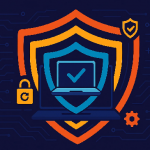
In today’s digital-first world, businesses are inundated with vast amounts of data. From financial transactions to intellectual property, the data flowing through an organization’s network is its lifeblood. But as valuable as this data is, it’s equally vulnerable. Enter Data Loss Prevention (DLP), a critical line of defense for any organization hoping to safeguard its most prized digital assets.
While external threats like cybercriminals often grab the headlines, a growing concern for businesses worldwide is the insider threat. These threats don’t come from shadowy figures in distant countries; they emerge from within an organization. They could be a disgruntled or former employee or even an uninformed team member inadvertently placing sensitive data at risk.
The true challenge with insider threats is their unpredictability and the fact that these individuals often have legitimate access to the data they’re compromising. That’s what makes understanding and managing insider threats not just crucial, but indispensable. As we dive deeper into the world of DLP, we’ll uncover the intricacies of insider threats, their indicators, and how organizations can stay one step ahead.
What is an Insider Threat?
An insider threat is a potential risk to an organization’s sensitive information, intellectual property, or critical assets that originates from within the company itself. These threats are unique because they come from individuals who often have legitimate access to the company’s data. This makes them harder to detect, and their motivations can range widely.
Types of Insider Threats:
1. Accidental Insiders: These are well-intentioned employees or stakeholders who unintentionally put the company’s data at risk. Common scenarios include mistakenly sending sensitive data to the wrong person or falling victim to social engineering attacks.
Example: Imagine an employee who accidentally emails a document containing trade secrets to an external party instead of a colleague.
2. Malicious Insiders: These individuals have harmful intentions and actively seek to exploit their access to cause harm for personal gain. This group can include disgruntled employees, former staff with lingering access, or individuals bribed by external parties.
Example: A terminated employee who still has access to the company’s system and decides to leak critical data as revenge.
3. Compromised Insiders: In this scenario, the threat isn’t the employee but an external entity that has managed to compromise the employee’s credentials. While the attack is from an outside source, it appears and operates as an insider.
Example: Cybercriminals employing phishing techniques to gain a trusted employee’s login credentials and then access the company’s sensitive data.
While the risks associated with each type differ, the unifying factor is the potential damage they can cause. From data breaches impacting an organization’s reputation to the loss of competitive edge due to leaked intellectual property, the ramifications of not addressing insider threats can be severe.
Why Insider Threats Pose a Unique Challenge
The complexities surrounding insider threats often lie in their deceptive simplicity. At first glance, the activities of an insider threat might appear no different from everyday operations, which is precisely what makes them so elusive and dangerous. Here’s a closer look at why these threats are a unique challenge for organizations:
- Familiarity with Systems and Processes: Insiders, by definition, are familiar with an organization’s systems, processes, and security measures. They know the nooks and crannies, the vulnerabilities, and often, the ways to bypass security protocols.
- Legitimate Access Rights: Detecting a breach is challenging when the person accessing the data has the right to do so. This blurs the line between normal user activity and suspicious activity, making detection more nuanced and complex.
- Lack of Clear Boundaries: While external threats often have to breach a clear boundary – like a firewall – insiders already operate within these boundaries. Their malicious or negligent actions might not appear as a security threat.
- Varied Motivations: Understanding the ‘why’ behind insider threats is as critical as knowing the ‘how.’ From personal grievances to financial incentives, the motivations can be multifaceted, making it harder to predict and detect potential threats.
- Rapid Evolution of User Behavior: As organizations grow and adapt, so do the roles and responsibilities of their employees. What might be considered unusual behavior one month might be standard the next. Keeping up with these changes while ensuring security can be a tightrope walk.
- Intermingling of Personal and Professional: With the rise of BYOD (Bring Your Own Device) policies and the blending of personal and professional lives online, there’s an increased risk of sensitive data being exposed inadvertently on less secure personal devices or platforms.
The stakes are high. Beyond the immediate loss of sensitive data or intellectual property, insider threats can erode trust within an organization, damage its reputation, and have legal and financial repercussions. It’s not just about preventing data loss but preserving the integrity and trustworthiness of an institution.
Insider Threat Indicators: Spotting the Warning Signs
Being proactive is the key to mitigating the impact of insider threats. Recognizing the early warning signs can make a considerable difference in prevention and response strategies. Here are some of the most prominent insider threat indicators to watch out for:
- Unusual Access Patterns: If an employee is accessing data or systems outside of their regular working hours or from unfamiliar locations, it might be cause for concern. For instance, an IT admin accessing financial data at night could be a red flag.
- Increased Data Transfers: A sudden surge in the volume of data being transferred, especially to external drives or cloud storage, can be indicative of a potential data breach.
- Repeated Login Failures: While occasional login issues are normal, repeated failures, especially across multiple systems, might suggest an insider is attempting to gain unauthorized access.
- Bypassing Security Protocols: If there’s evidence of an employee trying to bypass security measures, disable logging, or clear logs, it could be a sign of malicious intent.
- Changes in Employee Behavior: While not strictly a technical sign, shifts in an employee’s behavior or attitude can sometimes hint at underlying issues. A suddenly disgruntled or disengaged employee might pose a risk, especially if they have access to sensitive information.
- Unauthorized Use of External Storage or Devices: If employees plug in unauthorized external devices to the company’s network, it could be a potential avenue for data theft.
- Abnormal File Activities: Be it repeated attempts to access restricted files, unexpected file deletions, or modifications – any unusual file activity should be monitored closely.
- Unexpectedly Elevated Privileges: If a user suddenly acquires higher privileged access without a clear reason, it could be an indicator of compromise or insider manipulation.
- Frequent Use of Anonymous or Incognito Browsing: While there are legitimate reasons to use anonymous browsing, frequent reliance on such modes, especially in conjunction with other warning signs, can be concerning.
By recognizing these signs early, organizations can better position themselves to act swiftly and decisively, minimizing potential damage.
Building an Effective Insider Threat Program
As the adage goes, “Prevention is better than cure.” Given the unique challenges posed by insider threats, organizations must proactively prepare. Here are the best practices for crafting a robust insider threat program:
- Understand and Catalogue Sensitive Data: Begin by identifying what constitutes ‘sensitive information’ for your organization. This could be intellectual property, trade secrets, customer data, or any other critical assets. Knowing what you’re protecting is the first step.
- Implement Strict Access Controls: Employ the principle of least privilege (PoLP). Ensure that employees have access only to the information they absolutely need for their roles. Regularly review and update access permissions.
- Regular Training and Awareness Programs: Host frequent insider threat awareness sessions. Equip your employees with knowledge about the latest insider threat indicators, safe online practices, and the importance of reporting suspicious activities.
- Monitor User Activity Consistently: Implement user behavior analytics tools to monitor and analyze user activities. This will help detect deviations from baseline behavior, which could be indicative of insider threats.
- Create a Reporting Mechanism: Foster an organizational culture where employees feel safe reporting any suspicious activities or behaviors. A clear, confidential reporting mechanism can be invaluable.
- Frequent Security Audits: Security teams should regularly conduct security audits to identify vulnerabilities and assess the effectiveness of your security measures.
- Establish a Response Plan: In case of a detected insider threat, have a clear action plan. This should detail the steps for containment, investigation, communication, and recovery.
- Collaborate with HR: Human Resources can offer insights into employee behaviors and grievances. A collaborative approach can help identify potential threats stemming from disgruntled employees or other personal motivators.
- Deploy Insider Threat Detection Tools: Invest in insider threat software and solutions that are specifically designed to detect and mitigate insider threats. This could include DLP tools, endpoint security solutions, and more.
- Continuous Review and Adaptation: The cybersecurity landscape is ever-evolving. Regularly review and update your insider threat program to account for new risks and challenges.
By institutionalizing these best practices, organizations not only protect their sensitive data but also foster a culture of security awareness and vigilance.
Conclusion
In the digital age, where data is the new currency, ensuring its safety from both external and internal threats is paramount. Insider threats, given their unique nature, require a multi-faceted approach that combines technical safeguards with human insights. By understanding the challenges, recognizing the signs early, and instituting a robust insider threat program, organizations can better safeguard their most precious assets.
Remember, fostering a culture of security awareness is just as crucial as deploying the right software solutions. Stay vigilant, stay informed, and always prioritize the safety of your organization’s data.
Download our free ebook on
Data Loss Prevention Best Practices
Helping IT Managers, IT Administrators and data security staff understand the concept and purpose of DLP and how to easily implement it.
















